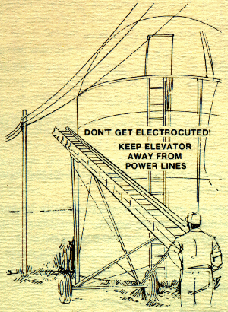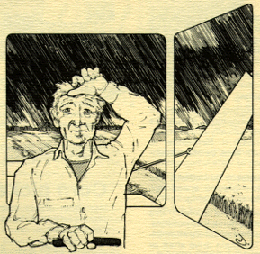 Good
weather and daylight hours always seem to be at a premium when
you are trying to gather nature's bounty in top condition. Planned
maintenance and skilled equipment operation can minimize downtime
and reduce potential for accidents during harvest.
Good
weather and daylight hours always seem to be at a premium when
you are trying to gather nature's bounty in top condition. Planned
maintenance and skilled equipment operation can minimize downtime
and reduce potential for accidents during harvest.
This
fact sheet does not provide a nuts and bolts description of
every piece of harvesting machinery. Such information is detailed
in operator's manuals. All individuals who operate field equipment
should thoroughly familiarize themselves with the appropriate
instruction manuals, so they will know how (and when) to carry
out routine maintenance and operate the machinery in a safe,
efficient manner.
We've
attempted to focus on key factors most commonly associated
with harvest time injuries and deaths. The point-form method
of presenting this information provides farmers with a handy
checklist that can be used to train family members and employees
who will operate specific machines. Anyone - from novice through
seasoned operator - can benefit by reviewing this material
before starting their engines!
Safe
completion of any task depends on knowledge, alertness and hazard
awareness. It's natural for us to take pride in our ability
to work long hours in pursuit of a goal. Nowhere is this more
evident than in harvesting operations. However, fatigue, drowsiness
and illness frequently contribute to mishaps in the field. Recognize
when you have "had enough", and turn the operation over to someone
else.
Adverse
weather definitely adds to harvesting pressure. Don't rely
on stimulants to keep you going, or take depressants to calm
your nerves. Drugs and alcohol work against the keen awareness
that is vital to safety.
Periodic
breaks relieve the monotony of machinery operation. If you
are going to eat in the field, at least climb down from the
machine and relax for 15 to 20 minutes.
Equipment
operators should be dressed for comfort and safety. Protective
footwear and close-fitting clothes are essentials when working
in and around machinery. Appropriate safety gear should be
worn where noise, dust, or toxic materials pose hazards.
Equipment should be made 'harvest-ready' in the off-season,
or at least several weeks in advance of use. It takes time to
get machinery into safe, efficient operating condition. You
may also need lead time to obtain replacement parts.
All
routine maintenance should be carried out on schedule. Evening
fuel fill and lubrication ready equipment for the next day,
and prevent condensation and corrosion.
All
guards and shields should be secured before equipment is started.
These protective devices reduce the potential for individuals
getting caught up in moving parts.
Hydraulically-raised
equipment should be securely blocked before anyone starts
working around or under the machine.
Never
attempt to clear plugged equipment by hand while power is
engaged! The brain can't give us the message to let go of
crop material quickly enough if the machine suddenly clears
itself. With the power of modern equipment, dismemberment
and/or death will be the likely result of entanglement. Alert
operators develop a habit of always shutting off the power
before leaving the driver's seat.
Fire
is a hazard in the field, particularly during cereal grain
harvest. Every piece of powered equipment should carry a fire
extinguisher.
Kids
are a 'no-no' around machinery. Far too many tragedies occur
when youngsters end up in the path of equipment from which
the operator's view is restricted.
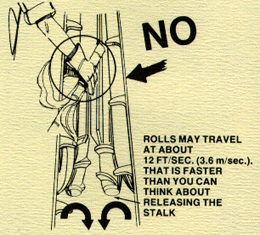
Operation
of ear corn pickers and picker/shellers requires many of the
same precautions as outlined for combine use.
Snapping
rolls can pull you in faster than you can think to let go.
Don't try it!
- Never
attempt to clear plugged snapping rolls while the
power is engaged. Countless farmers have lost fingers or
hands as a result of trying to pull a stalk free from an
operating picker. You simply can't think fast enough to
let go in time if the plug clears itself!
- Husking
rolls can catch gloves, fingers, or hands. Always disengage
power before doing any cleaning or adjusting around the
husking bed.
- Similarly,
shut down the machine before attempting to clear a plugged
cylinder on a picker/sheller.
- Take
special care to avoid jack-knifing the trailed picker and
wagon when moving down steep slopes.
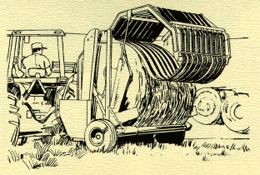
No
one should be near the rear of a large round baler while a
bale is being ejected.
Timely
harvest of high quality forages can be pivotal to the success
of a livestock operation. A bad turn in the weather adds considerably
to emotional stress - rushing to 'beat' the elements is often
a factor in hay crop harvesting accidents.
A variety
of equipment is used in the process of converting forage crops
into stored feeds. Many of these machines are PTO-driven.
Power shaft accidents are among the major causes of severe
injuries and deaths on the farm. All PTO components must be
properly guarded to minimize the potential for carnage!
Power should always be disengaged before anyone attempts to
make adjustments or clear a plugged machine.
Cutting equipment
- Never
try to adjust or clear cutterbars, reels, or conditioning
rolls without disengaging power. Even when stationary, these
devices pose a threat because of sharp edges, points, etc.
Avoid rushed movements when working close to the equipment.
- Flail
mowers should be properly shielded to prevent a flail from
becoming a lethal projectile if it happens to break loose.
- No
one should stand near the rear of operating conditioner
rolls, since a stone or other object could be thrown from
the equipment with considerable force.
- Be
on the lookout for stones, groundhog holes and uneven terrain
when cutting forage crops. High speed contact with such
obstacles can seriously damage equipment, or - in the case
of a self-propelled windrower - cause the operator to lose
control of the machine.
Conventional balers
- Balers
should be thoroughly serviced well in advance of the major
season of use. Check timing, operation of knotter, condition
of knives, etc.
- The
flywheel maintains the uniform momentum of a baler's working
parts. It also keeps the machine operating for a considerable
time after power is disengaged. Never attempt to
work on a baler until the flywheel has come completely to
rest.
- The
flywheel can be turned manually to permit slow motion observation
of knotter function. However, it should never be turned
while someone else is working on the knives, knotter, or
other moving parts.
- Never
allow anyone to ride in a wagon if a bale thrower is being
used.
Large round balers
- Don't
eject big bales where they could start rolling.
- No
one should be near the rear of the machine when a bale is
being ejected.
- Never
attempt to service or clear a machine with the power engaged.
- Purpose-designed
equipment should be used to handle and transport large bales.
Proper tractor weighting and methodical operation will prevent
overturns.
Forage harvesters
Large,
modern forage harvesters have awesome power. Please don't try
to work anywhere near these machines unless the engine is shut
off and the key is in your pocket!
- Stay
well clear of the discharge spout while the harvester is
operating. To avoid being hit by objects from the spout,
make sure the machine is completely stopped before hooking
up wagons.
- Doors
and shields must be tightly latched during operation to
deflect objects thrown by the cutter.
- Components
may continue to rotate for several minutes after the power
is shut off. Don't open doors until all parts have stopped
moving.
- Knives
must be kept sharp and properly balanced for safe, effective
operation. Follow maintenance procedures specified in the
owner's manual.
- To
avoid loss of control, disengage power rear-wheel drive
on self-propelled harvesters before traveling on icy roads
or highways.
Portable augers and elevators
Farm wagons
- Maintain
steering components, wheel bearings and other parts of the
running gear to ensure that all wagons can be kept under
control during travel.
- Safety
locking hitch pins should always be used. Safety chains
are required on public roads.
- Don't
exceed load limits of the equipment, or of bridges you may
have to cross.
- Is
the tractor heavy and powerful enough to control the wagon
when fully loaded? This is particularly important when you
have to go up and down hills. Large wagons should be equipped
with their own brakes.
- Reduce
speed on corners and rough terrain, and keep the tractor
in gear when going downhill. A good thumb rule is to gear
no higher than you would to pull the same load up the hill.
Forage wagons
- Emergency
shut-off devices must be maintained in perfect operating
condition.
- These
wagons incorporate a myriad of hazards. Shafts, belts, pulleys,
beaters, chains, etc. must be guarded and shielded, to the
greatest extent possible.
- Some
parts must be exposed to do the work. Keep hands and feet
away from all moving parts.
- Stay
at the controls while the wagon is operating. Never step
over the power shaft.
- Don't
enter a wagon while the tractor engine is running.
- Always
shut the power off (and pocket the key) before attempting
to unclog any part of the mechanism or make repairs. Replace
all guards and shields before starting up again.
Self-unloading
grain wagons
- Make
grain wagons 'off limits' to children. Don't leave a wagon
load of grain unattended if there is any danger of kids
climbing in and becoming entrapped in the grain.
- Unload
wagons on a level surface. Don't drive up on blocks to try
to make the grain run out faster.
Forage blowers
- Fasten
a PTO blower securely to the tractor drawbar. Vibration
could cause an unattached blower to move, thereby allowing
the telescoping PTO shaft to come apart and rotate dangerously.
Movement could also bring the blower pipe down on you.
- Never
climb into the hopper or use hands or feet to force material
into a blower.
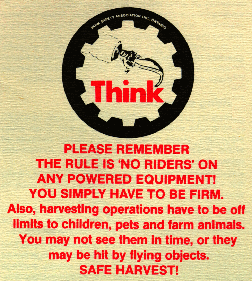
PLEASE REMEMBER
THE RULE IS 'NO RIDERS' ON ANY POWERED EQUIPMENT! YOU SIMPLY
HAVE TO BE FIRM. Also, harvesting operations have to be off
limits to children, pets and farm animals. You may not see them
in time, or they may be hit by flying objects. SAFE HARVEST!
ILLUSTRATIONS
ON PAGES 2, 3 AND 4 COURTESY OF DEERE AND COMPANY.
Publication #: F-016
The information and recommendations contained in this publication
are believed to be reliable and representative of contemporary
expert opinion on the subject material. The Farm Safety Association
does not guarantee absolute accuracy or sufficiency of subject
material, nor can it accept responsibility for health and safety
recommendations that may have been omitted due to particular
and exceptional conditions and circumstances.
Farm
Safety Association Home Page
Disclaimer and Reproduction Information: Information in
NASD does not represent NIOSH policy. Information included in
NASD appears by permission of the author and/or copyright holder.
More
 Good
weather and daylight hours always seem to be at a premium when
you are trying to gather nature's bounty in top condition. Planned
maintenance and skilled equipment operation can minimize downtime
and reduce potential for accidents during harvest.
Good
weather and daylight hours always seem to be at a premium when
you are trying to gather nature's bounty in top condition. Planned
maintenance and skilled equipment operation can minimize downtime
and reduce potential for accidents during harvest.
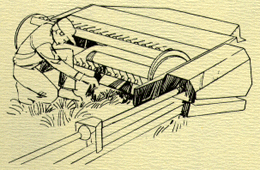 Make
it a habit to always shut off power before working on equipment.
Make
it a habit to always shut off power before working on equipment.
 Corn
picker hazards
Corn
picker hazards
